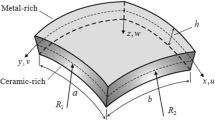Abstract
The split cylinder test is subjected to an analysis combining nonlinear fracture mechanics and plasticity. The fictitious crack model is applied for the analysis of splitting tensile fracture, and the Mohr-Coulomb yield criterion is adopted for modelling the compressive crushing/sliding failure. Two models are presented, a simple semi-analytical model based on analytical solutions for the crack propagation in a rectangular prismatic body, and a finite element model including plasticity in bulk material as well as crack propagation in interface elements. A numerical study applying these models demonstrates the influence of varying geometry or constitutive properties. For a split cylinder test in load control it is shown how the ultimate load is either plasticity dominated or fracture mechanics dominated. The transition between the two modes is related to changes in geometry or constitutive properties. This implies that the linear elastic interpretation of the ultimate splitting force in term of the uniaxial tensile strength of the material is only valid for special situations, e.g. for very large cylinders. Furthermore, the numerical analysis suggests that the split cylinder test is not well suited for determining the tensile strength of early age or fibre reinforced concrete.
Similar content being viewed by others
References
Lobo Carneiro F, Barcellos A (1949) A Résistance a la traction des bétons, RILEM Bulletin 13: 98–125.
Hillerborg A, Modéer M, Petersson P (1976) Analysis of crack formation and crack growth in concrete by means of fracture mechanics and finite elements. Cement and Concrete Res., 6(6): 773–782.
RILEM (2001) Test and design methods for steel fiber reinforced concrete. Recommendations for uniaxial tension test. Materials and Structures, 34(3–6), Prepared by RILEM-Committee-TDF-162, Chairlady L. Vandewalle.
Ostergaard L (2003) Early-age fracture mechanics and cracking of concrete – experiments and modelling, PhD-thesis, Department of Civil Engineering, Technical University of Denmark.
Ostergaard L, Olesen JF, Stang H (2001) Modelling simultaneous tensile and compressive failure modes of the split cylinder test. In: L Beldie, O Dahlblom, Olsson A, Ottosen NS, Sandberg G, (eds) Proccedings of the 14th Nordic Seminar on ComputationalMechanics, pages 193–196. Division of Structural Mechanics, Lund University, Sweden, October.
Olesen JF (2001) Fictitious crack propagation in fiber-reinforced concrete beams. Journal of Engineering Mechanics 127(3): 272–280, March.
Nielsen MP (1999) Limit Analysis and Concrete Plasticity. CRC Press, 2nd edition.
Ostergaard L, Lange D, Stang H (2003) Early-age stress crack opening relationship for high performance concrete. Cement and Concrete Composites, Accepted.
Rocco C, Guinea GV, Planas J, Elices M (2001) Review of the splitting-test standards from a fracture mechanics point of view, Cement and Concrete Research 31: 73–82.
Timoshenko SP, Goodier JN (1970) Theory of Elasticity. McGraw-Hill, 3rd edition.
Tang T (1994) Effects of load-distributed width on split tension of unnotched and notched cylindrical specimens. Journal of Testing and Evaluation 22(5): 401–409, September.
Chen WF, Drucker DC (1969) Bearing capacity of concrete blocks or rock. Journal of Engineering Mechanics Div., ASCE, 95(EM4): 955–978, Aug.
Izbicki RJ (1972) General yield condition: I. plane deformation. Bull Acad Pol Sci Ser Sci Tech, 20(7–8).
DIANA (2000) DIANA Manual, TNO Building and Construction Research, P.O. Box 49, 2600 AA Delft, The Netherlands, 8.0
Rocco C, Guinea GV, Planas J, Elices M (1999) Size effect and boundary conditions in the brazilian test: theoretical analysis. Materials and Structures 32: 437–444.
Author information
Authors and Affiliations
Rights and permissions
About this article
Cite this article
Olesen, J.F., Østergaard, L. & Stang, H. Nonlinear fracture mechanics and plasticity of the split cylinder test. Mater Struct 39, 421–432 (2006). https://doi.org/10.1617/s11527-005-9018-3
Received:
Accepted:
Published:
Issue Date:
DOI: https://doi.org/10.1617/s11527-005-9018-3




